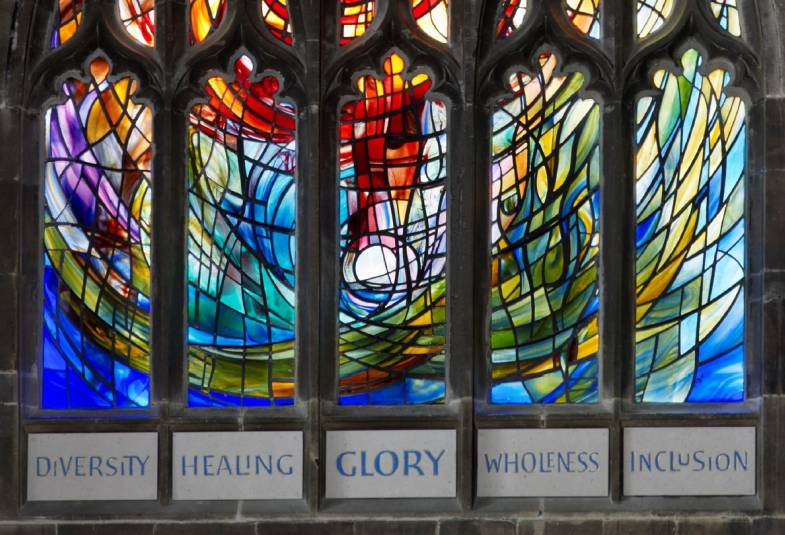We want our churches and cathedrals to be places of welcome and solace for all. Our guidance helps you to assess how, and to what extent, objects that may be symbols of injustice or sources of pain may impact on your ability to undertake activities in your church or cathedral. It helps you to work through different options that are available to address the contested nature of your heritage.
This is not about judging people in the past by the standards of the present, but about how items of contested heritage, and wider issues of under-representation, affect our ability to be a Church for all in the 21st century, and how you can help to redress imbalances.

Download Our Guidance
There are two versions of our guidance.
The short guidance provides an introduction to the issues raised by items of contested heritage in our cathedrals and church buildings, and approaches to addressing these issues.
The long guidance contains a more thorough discussion of these issues and considers the possible options for change in more detail. It should be consulted by any church or cathedral considering taking action to address one or more items of contested heritage in their building.
What Can You Do?
There are lots of ways that you can address your contested heritage. Our checklist can help you work through the process of selecting and implementing the approach that is right for you.
The process always begins with thorough research. Statements of significance and needs are good ways for you to record your research.
Once you have researched your objects, and assessed the need for change, there are a number of approaches you can take to addressing the issues you have identified. Each of these options has the potential to affect both the object itself and the mission of your church or cathedral. Our Options Matrix lays out some of these potential effects, both positive and negative. You can use the options matrix to consider these possibilities, and to decide which is the best option for your church or cathedral.
At each stage in the process, you should consult with those affected by the items now, and those who may be affected by any changes you propose. These can be difficult conversations to have. The Church’s Pastoral Principles can help you to guide these conversations with LOVE (Listen attentively and openly, Open your heart & mind without judgementalism, Value everyone’s vulnerability and perspective, Express concern and empathy). It is important to bear in mind that legal permission may be required to make changes to an object.
Do You Need Legal Permission For Your Chosen Option(s)?
It depends.
If your changes are not to the object itself, such as re-writing your church brochure, adding information to your inventory or website, or putting up a freestanding board with new interpretation information, then you can go ahead without any further permissions. If you are making minor changes, check with your Archdeacon whether permission is needed. Although minor changes do not normally need a faculty, works that affect monuments or other historically significant furnishings usually do. As how we understand monuments is currently going through a time of change, even a small action should only come after discussion with those the change will impact, even when the Archdeacon is content that formal permission is not needed.
If you want to make lasting changes to the object or your building, such as changing the inscription, installing a new artwork, moving the object, or disposing of the object, then it is likely you will first need to obtain legal permission, following a formal process of consultation with heritage bodies such as Historic England and the statutory amenity societies.
You can find more information on permissions for churches here and cathedrals here
Planning approval and building regulations might also be required
What Happens Next?
For all of the decisions that you make, it is important that you record them, and communicate them. This may be in the parish newsletter, on your website, or in an article in a local newspaper. Make sure that you have let all those who were part of the process know the outcome of your work
Want More Help?
For further help, please to contact your DAC or the Cathedral Fabric Advisory Committe in the first instance. You can also contact us for further advice and support.
CBC Contested Heritage Committee
The Contested Heritage committee is a committee of the Church Buildings Council. Its members
give us advice on contested heritage cases and policy. We make sure that your project benefits from their expert advice.
Committee members
Novelette-Aldoni Stewart (Chair)
Professor Michael Berkowitz (Professor of Modern Jewish History, University College London)
Professor Arthur Burns (Professor of Modern British History, Kings College London)
Dr Renie Chow Choy (Associate Lecturer, Westcott House Cambridge; Collections Community Engagement Manager, St Paul's Cathedral)
Revd Canon Dr Nicholas Cranfield (Vicar, All Saint’s Blackheath)
Chloe Meredith (Project Manager, Learning & Participation, Churches Conservation Trust)
Right Revd Jonathan Meyrick (Honorary Assistant Bishop, Dioceses of Peterborough & Oxford)
Ramond Mitchell (Director of Liturgy & Arts, St George-in-the-East, London)
Revd Daniel Ramble (Area Dean, Oldham & Ashton, Diocese of Manchester)